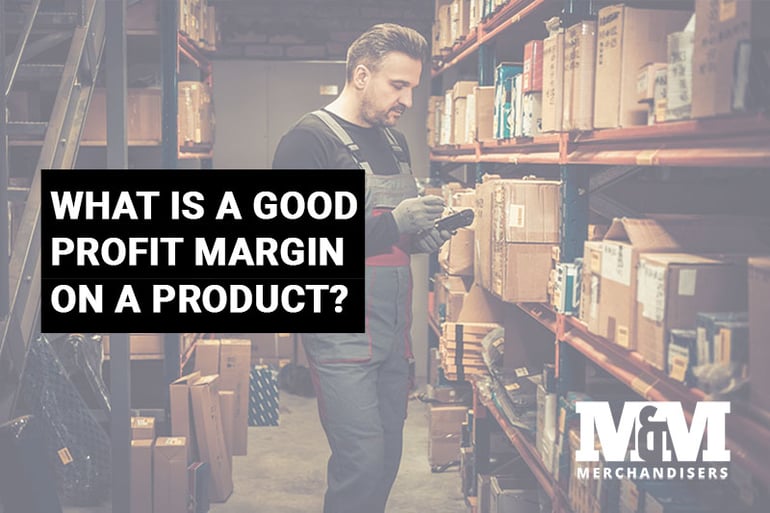What Is a Good Profit Margin on a Product?

When you've stocked your inventory, you want to make sure that it moves at a regular and expedient pace. If you think your products are moving too slow, you might consider tweaking your price point. But with so much competition in the market, how do you know if you have adequate pricing on your merchandise? Here are some strategies that can help you understand your profit margins and figure out what is best for your business.
Need a wholesale supplier to help your business's profit margins?
M&M Merchandisers can give your business the edge it needs.
What Is Profit Margin?
A profit margin describes how many cents of profit a company makes for each dollar of sales. It's denoted by a percentage and gives you an idea of what percentage of sales has become your profits. So if someone tells you their company has a 43% profit margin, it means they are making $0.43 per dollar of sales. This number takes into account profits after business expenses, payment of employees, and taxes have been subtracted.
Profit margins are also great ways to describe to others the viability of your company. If you ever look for investors or want to sell your company, having a high profit margin will better your chances of making a great business deal in your favor. It will also help you in the event that you ever want to expand your business using a small business loan. Banks take profit margins into account when deciding who receives a large loan.
Average Profit Margin Formula
Here is a simple way to calculate a fair and average profit margin for your products. A simple formula is to divide net income by net sales. Your net income encompasses all your profits minus any expenses. The net sales are all your sales minus any discounts you've offered and any returns you've accepted. Across industries, the average profit margin is about 10%, but yours will depend on your industry and clientele.
What Is a Good Profit Margin on a Product?
When you are trying to figure out what a good profit margin should be on one of your products, it's important to consider several different factors. First, you'll have to take into account all of your expenses. This would include indirect costs like office expenses, salaries and utilities. Second, it's a good idea to look at the price points of your competition on specific products. After doing your research, you can make the necessary adjustments to your prices.
Average Profit Margin by Industry
Depending on what industry you business focuses on, you will have different profit margins associated with your products. For instance, there will be a difference between a business that serves plumbing companies and one that caters directly to consumers buying bulk party supplies.

What Is a Fair Markup on Products?
Buyers and consumers really want to get the best deals that they can, but so do you for your business and employees. You must keep in mind all your business expenses and the price at which you paid for the product. Then you must take into account your efforts and what they have been worth for you to supply this product to the public. In essence you are setting the price you are paying yourself and your employees.
How Much Should I Mark Up My Products?
You have to have a markup on your products because this is how you, the retailer, turns a profit. Remember you need to take into account all your indirect expenses, employee salaries and the price at which you purchased the item or items. The markup percentage is the gross profit divided by the sales price.
You will need to decide how much you want to mark up a certain product. If you buy an item for $2.00 and sell it for $7.00 then your markup and profit would be $5.00. the markup percentage of this would be $5 divided by $7, which is 0.714 or a 71 percent markup.
There is no average markup for any particular product. High end and luxury items routinely have high markup percentages on products that their consumers eagerly spend their money on. However, higher markups do not always equal higher profitability and may actually lower your profit margin. If items are priced too high for the market, you may lose your sales to your competitors. It's important to watch your competition closely.
Different items in your inventory should also have different markups dependent on factors such as demand. Perhaps you are the only company that carries a certain hard to find product. This would allow you to set the price point. If a competitor happens to start selling this coveted product, you'd have to adjust your markup which would ultimately change your profit margin.
Tips for Pricing Your Products to Sell
Setting the correct price for your products doesn’t have to be tricky. Here are some tips for finding the right pricing strategy for your inventory and ending up with a high profit margin.
- Take a look at the MSRP: The manufacturer suggested retail price is the price point that the manufacturer suggests their product be sold. In many regards, the manufacturers are the best people to take pricing information from because they have done the research about their products and taken consumer feedback. If an MSRP is offered for a particular product, it makes sense to try it and see how your inventory moves.
- Double the wholesale cost: This is the tried and true simple way to figure out merchandise pricing. However, it doesn’t always work for every product. If an item that doesn’t have consistent sales, you might be sitting on your inventory for quite a long time. A lesser markup may work to make the product move. However, this is an easy strategy for pricing if you aren’t sure exactly how to price an item.
- Give people a deal if they bundle: If you want to sell more quantity of a product, it may benefit you to offer bundle pricing. This is a great way to encourage large orders from your frequent clients. It also creates a sense that they, as consumers, are getting a better deal. It’s a win-win for everyone.
- List the anchor pricing: Anchor pricing simply listing the original price next to a newer discounted price. This also creates the idea that the consumer is finding a worthy deal. Many big online retailers use this strategy to increase sales.
- Premium pricing for the discriminating shopper: As previously mentioned, luxury items have a high markup percentage. Consumers literally will line up around the block to purchase these items from fancy retailers. You may have some products to which you might try attaching a luxury premium price. This can be a tricky tip to navigate, so be sure to do your research on product demand and availability.
- Beat the competition: Again, you must watch the pricing patterns of your direct competitors to stay on top of the latest market prices. You can be that company that drives competition by lowering your prices to less than your rivals. This works some retailers and has backfired for others. It may be a good idea to try this strategy slowly, starting with just a few products that tend to sell quickly.
- End all of your pricing with an odd number: Why is it that nearly every product is sold for an oddly numbered price, such as $7.99 instead of an even $8.00? Market researchers have found that consumers are attracted to prices that end in an odd number. This means consumers are more likely to buy a particular product for $39.99 than for $34.00. Be sure to end your pricing with an odd number.
- Encourage your customers to make multiple purchases: You’d like every customer to buy more than one item when they shop with you. Well, there are very practical ways to encourage this behavior. Take note of items in your inventory that are traditionally purchased together. You can either offer a special deal if a consumer buys them both, or you could simply suggest the second item every time a customer makes a purchase of the first item.
Related: How to Increase Sales in a Pawn Shop
Remember, not every pricing strategy will work for every business or even every product. You need to do your research and figure out pricing strategies that work for you, your consumers, and the items you have in your inventory. Now that you’ve learned a bit about different pricing strategies, you’ll be able to make a more informed calculation of your company’s individual profit margin. This knowledge will help you to expand your business and profits into the future.
Posted by Lois Haycock
Lois Haycock is a 20+ year retail and eCommerce veteran specializing in project management and business analysis of customer-facing systems and software. Lois is SVP of Digital Transformation at M&M Merchandisers. She also operates several eCommerce stores as well as an executive coaching business. Lois can be reached at lois.haycock@mmwholesale.com


